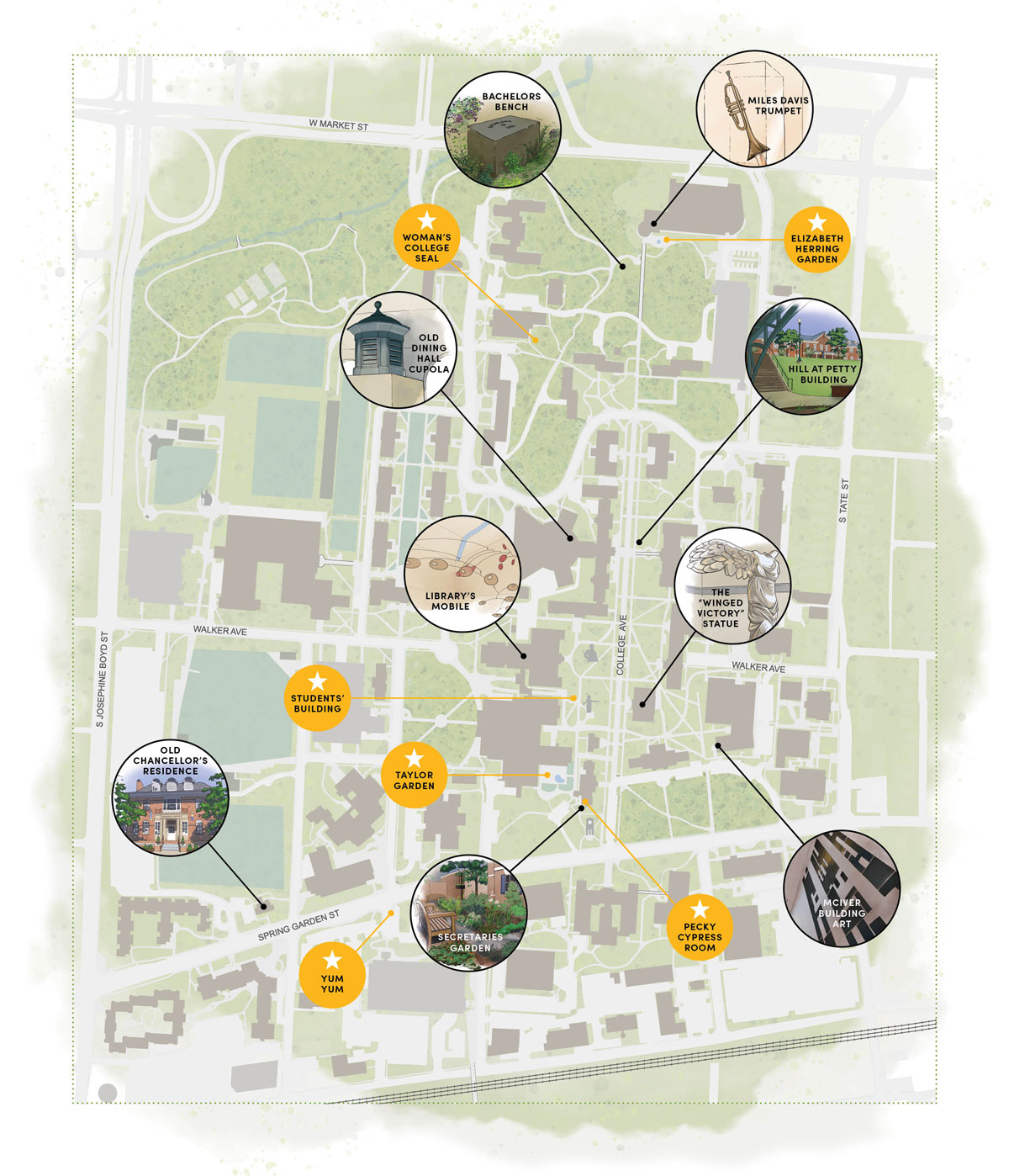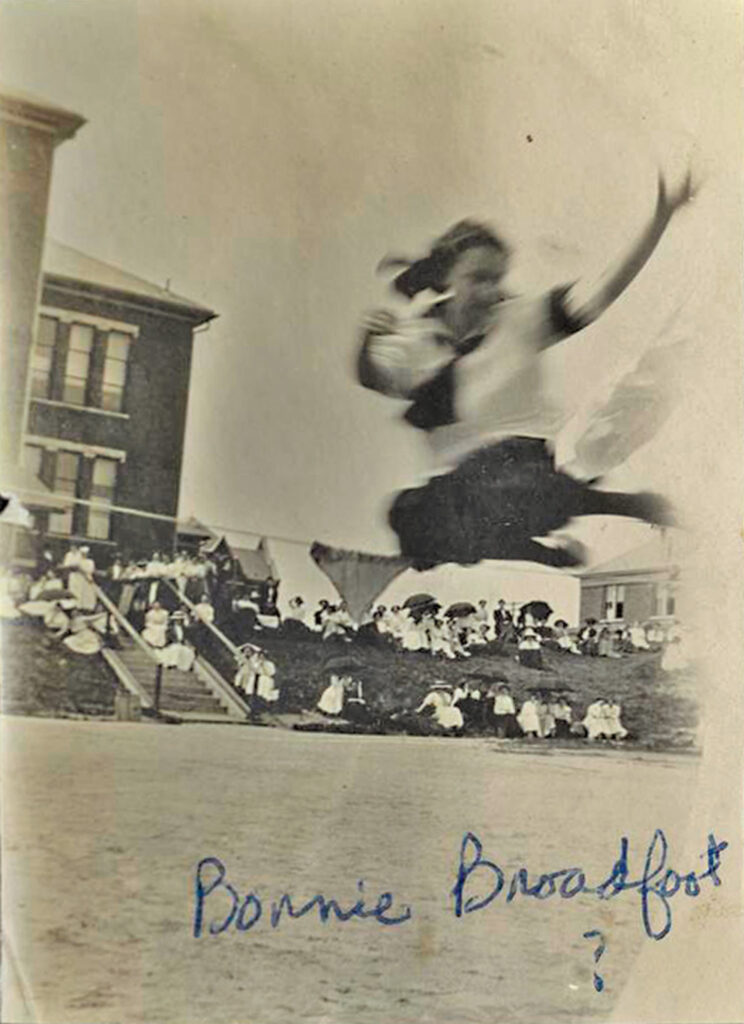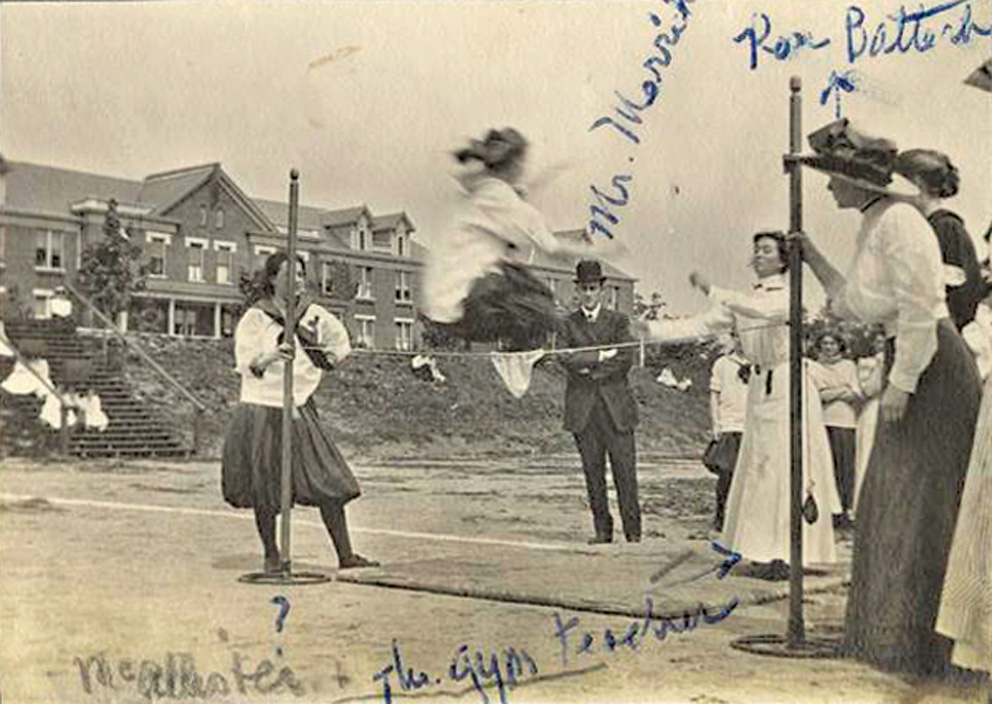
Hidden Gems Yield Hints of History
Beyond the flowering trees and fragrant wisteria, in the midst of Romanesque, neoclassical, neo-Georgian, and Modernist architecture, treasures abound at UNCG. Everywhere you turn, there’s a reminder of our campus’ storied past. Fact is, our University has a uniquely rich history, which the campus landscape reveals every day. The past is present here, on every path and around every corner.
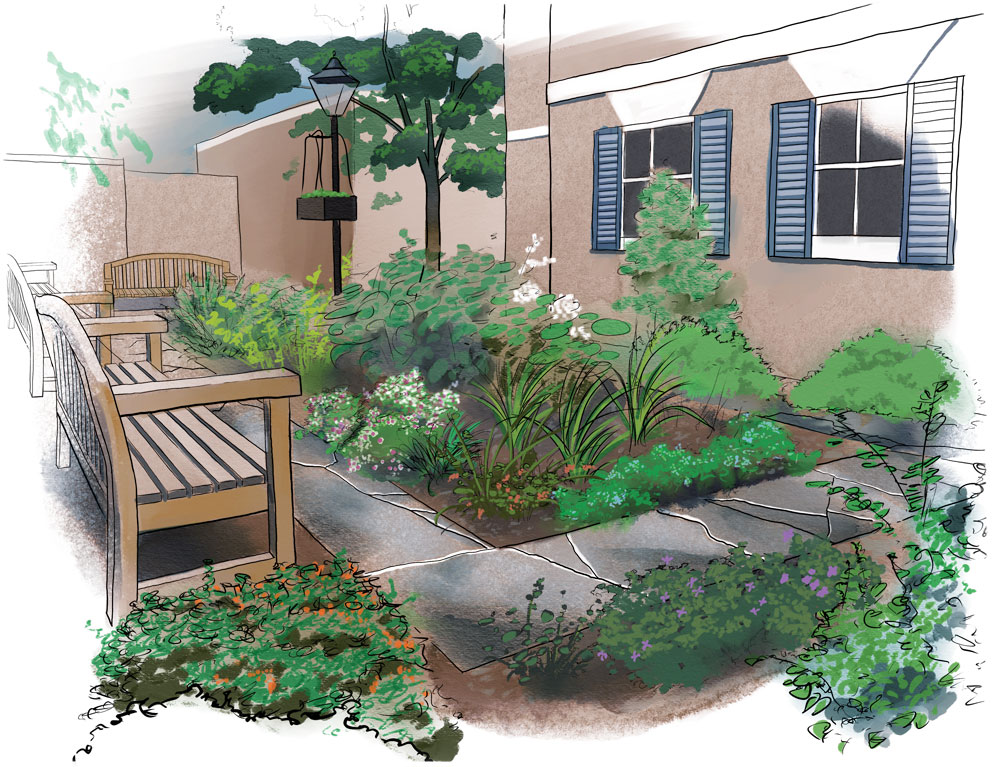
Smell the flowers
Talk about a secret garden. Bordered by the Alumni House and a retaining wall, this cozy space has been the Alumni Secretaries Garden since 1964. In fact, nearby is a marble bench inscribed “Class of 1964.” A garden wall bears a sign recognizing the first four alumnae leaders: Ethel Bollinger Keiger (1919-1922), Clara Booth Byrd (1922- 1947), Betty Brown Jester (1947-1955), and Barbara Parrish (1955-1989). In 2006, Susan Seeker Jones ’78 revitalized the Secretaries Garden through a gift to the Alumni House Furnishings Fund. Teaming up with then-Landscaping Department Head Chris Fay, she introduced benches and new plantings like irises, flowering bushes, and climbing camellias to the garden, which stands as a living memorial to her parents, Iris and “Bud.” The alumna said, “I never appreciated the garden when I was here. I want to make sure students don’t make the same mistake and take advantage of the many green spaces available.”
Take a peek into the Alumni House’s Pecky Cypress Room, which served as the chancellor’s office in the decade before Mossman Building opened. The cypress paneling from the swamps of Louisiana has a naturally occurring and highly desired “pecky” appearance.
Taylor Garden, with its kidney-shaped pond, is located behind Elliott University Center (originally Elliott Hall). In 1973 it was named for Katherine Taylor ’28, who taught French before serving as dean of students from 1948 to 1972.
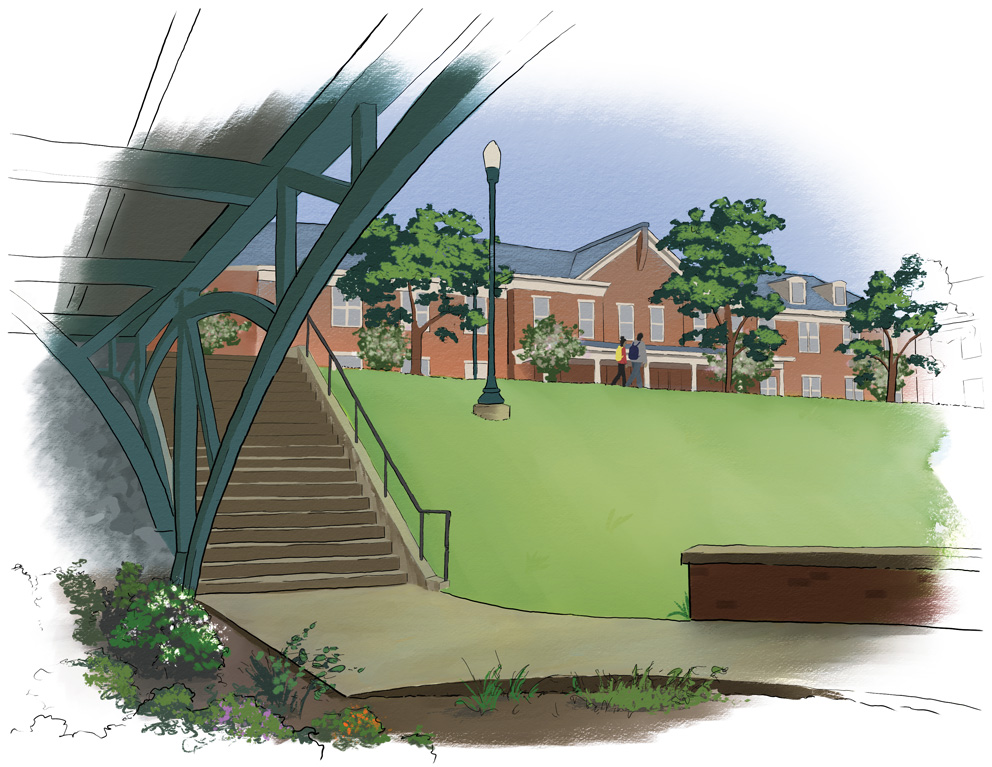
Perfect for sledding
In the first decades of our school, the athletic fields were located where Petty Building now stands. Field days, May Day celebrations, and field hockey games were all held here. When Charlie Chaplin appeared at a 1918 war bonds rally here, a reporter said he blew a kiss from the tips of his fingers to college women forming a “bank of bright color” in front of him. The slanted banks, which still exist, were perfect seating areas for the field. Once Petty Science Building was completed in 1940, students focused on another use: snow sledding! For decades, Spartans considered dining hall trays the ideal sleds, we understand. Today, the dining hall does not use trays in order to conserve water usage – and students have gotten creative. New York Pizza box, anyone?
For nearly 60 years, reaching Petty was a workout. Down steps, up steps. In 2007, a pedestrian bridge opened. Did the students like the quick access to Petty, one patterned after Paris’s Pont des Arts on the Seine River? Oui!
A cornerstone near College Avenue and the swing marks where the stately Student’s Building once stood. From 1906 to 1950, it housed two departments, the bookstore, a 700-seat auditorium, and much more.
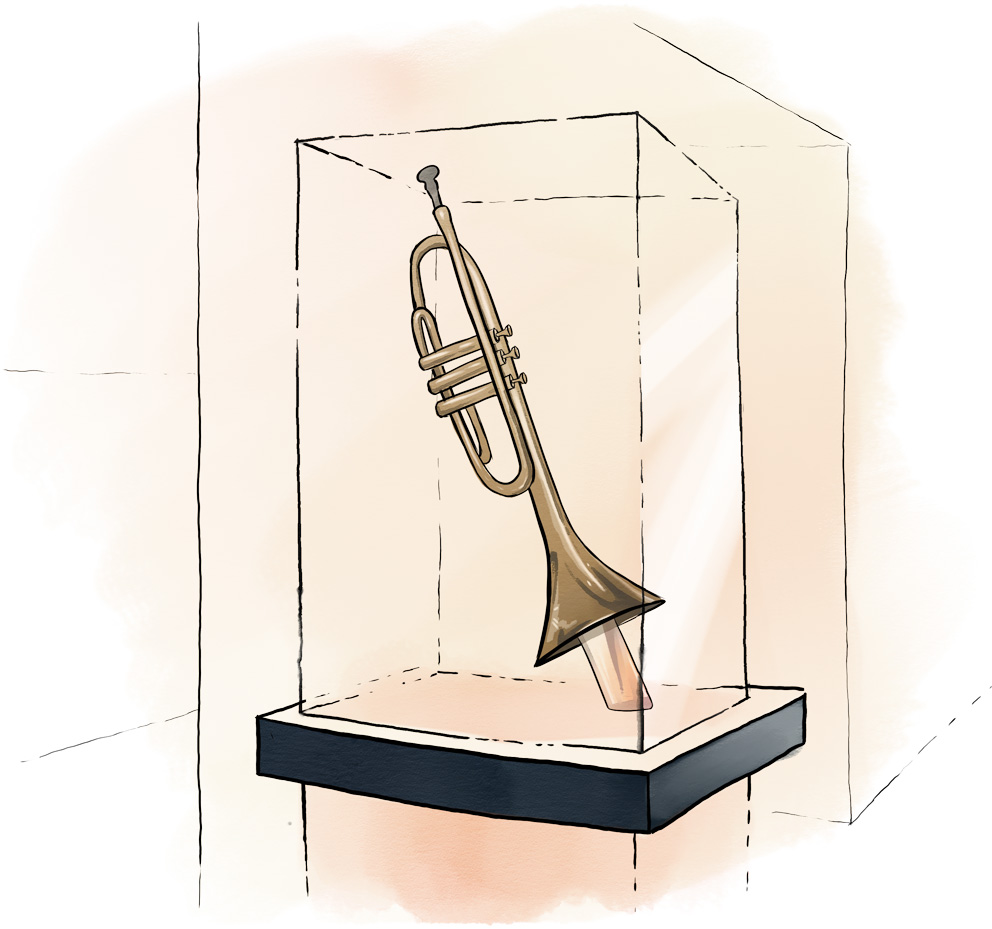
Jazz’s Excalibur
As you’re set to enter the Tew Recital Hall, a trumpet in a secure case welcomes you. It’s not just a Miles Davis trumpet. It’s the trumpet he played on the most popular jazz album of all time, “Kind of Blue.” Buddy Gist in 2001 officially gifted UNCG the trumpet that his old friend, Miles Davis, had given him. “Buddy would come and talk with our students,” says Professor Steve Haines. Gist wanted it to inspire future students of jazz, he explains. And it does. UNCG’s jazz program adopted the name Miles Davis Jazz Studies. And, with the support of more recent donors like Dr. Ward Robinson ’10 MPH creating the Robinson Scholarships, the jazz program is recognized as one of the finest such programs in the Southeast. All inspired by the horn featured in “Kind of Blue,” which Haines succinctly calls “one of the musical masterpieces of the 20th century.”
Enjoy framed prints of Miles Davis artwork lining a wall of the building’s Schiffman Music Library.
The statue in the center hall as you enter the Music Building is by Tom Otterness, who created the much-admired frieze in the Weatherspoon Art Museum atrium.
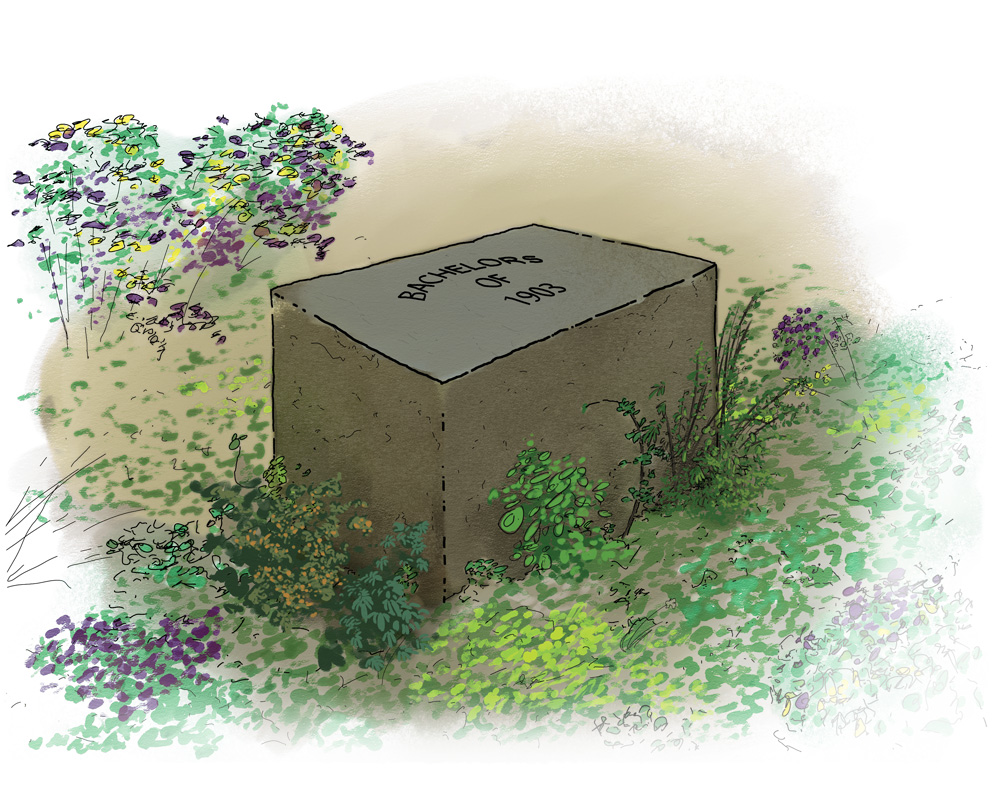
Nine degrees in the shade
In the first decade after the State Normal and Industrial School opened in 1892, students received diplomas but not degrees. “The diplomas were for mastery of the limited curriculum,” archivist Kathelene McCarty Smith says. In the spring of 1903, the campus reached a milestone in academic rigor: Nine students, who’d already received diplomas and had returned to complete additional coursework, received bachelor’s degrees. This first class of bachelor’s recipients was commemorated with this granite bench in Peabody Park. As the pathways evolved, the bench became covered over – but in recent years, the vines have been brushed back. “Bachelors of 1903,” it reads on top. Perhaps because it was hidden all those years, McCarty Smith says, it is in splendid condition today.
The much-admired Elizabeth Herring Garden, beside the School of Music Building, was endowed by Dr. William B. Herring in honor of his late wife, Elizabeth “Betty” Hawks Herring. They were early members of UNCG’s Musical Arts Guild. At its dedication in 1999, it featured some of Betty’s own plants. We like to think they continue to bloom every spring.
A delightful Woman’s College seal is displayed near the southeast corner of Gove Health Center, in Peabody Park. This was featured on the Gove Health Center’s front facade for decades, before the building’s dramatic renovation and expansion.

Always the center of attention
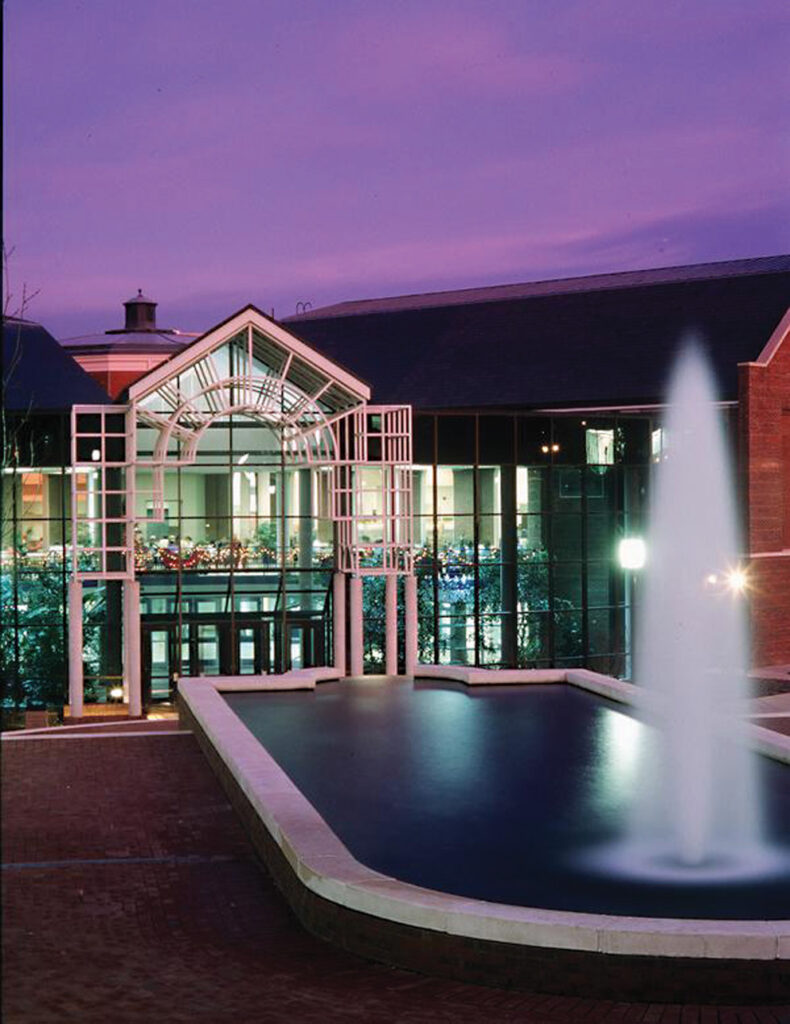
Spencer Dining Hall, built from 1904 to 1939, has five spokes. At the center of the dining hall area, like a center decoration on a cake, sat the old cupola. Its louvers apparently helped provide ventilation in pre-airconditioning days. The dramatic renovation a decade ago – the area was renamed Moran Commons – created a dining hall with additional spaces that students enjoy. When the cupola was replaced with a beautiful roof of exposed wooden beams, Fred Patrick, director of Facilities, Design, and Construction at the time, led the effort to preserve and display it. As a placard below the cupola in the dining hall states, “The cupola is displayed here so the architectural history and zinc metal craftsmanship can be admired for many more generations.”
Why does South Spencer Residence Hall have such an impressive facade with a low topographical profile? Until the late 1940s, it faced well-traveled Walker Avenue, which passed through campus, running under College Avenue.
North Spencer Residence Hall was said to have the longest hallways in a residence hall in the nation. History Professor Allen Trelease reported that students called it “Rockingham,” saying it stretched all the way to Rockingham County. The reason it’s only two stories? Immediately after fire destroyed Brick Dormitory in 1904 (no students were injured) and in an era with no fire sprinklers, President McIver and faculty wanted a replacement building low to the ground.

Airborne art
When Greensboro artist Alex Smoot gave this work to UNCG Libraries in 1971 – in honor of Charles M. Adams, library director from 1945 to 1969 – he was not only director of Wesley Long Hospital’s pathology lab but well-known for his photography and murals. His obituary says he ultimately created 86 mobiles, many on display in museums, homes, and public buildings. The Weatherspoon has a mobile by the famous Alexander Calder (currently not on view). Elliott Hall had a mobile, too, before its expansion as the EUC. But this large one in Jackson Library has long mesmerized students under the circulation desk’s skylights. “I regularly see people look up at it and sometimes stop and stare,” says Cathy Griffith ’82, head of Access Services. Talk about a sight to behold.
Ever notice Jackson Library’s “dumbwaiter” elevator? Since the opening in 1950, it’s been used to quickly transport books and other items. And yes, it’s inspected every year, just like every elevator in the state. Going up!
Artist Betty Watson ’65 MFA asked celebrated writer, critic, and professor Randall Jarrell to pose twice for portraits. One is held by the National Portrait Gallery in Washington, D.C. The other hangs in Jackson Library’s second floor.
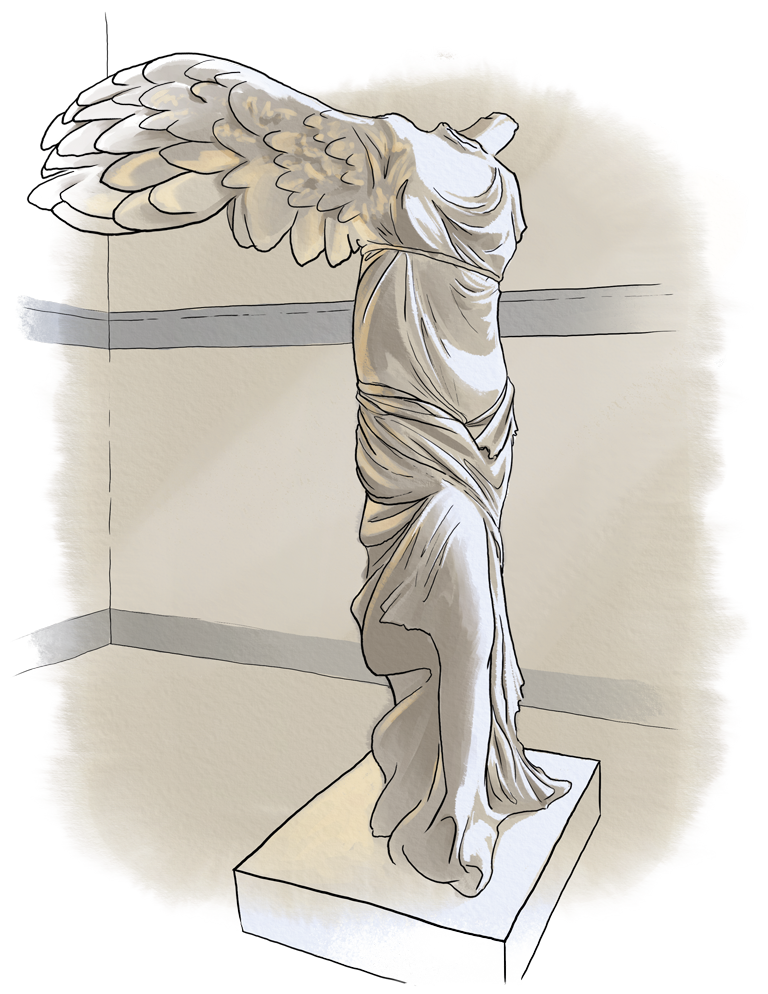
Have wings, will travel
The Winged Victory of Samothrace, created around 190 BC, unearthed in 1863, and displayed in the Louvre, is an anchor of that museum. A plaster replica of this famous statue, given in 1915 as the senior class gift, was made by the Caproni Brothers, archivist Scott Hinshaw points out. The makers’ mark is quite legible on the statue. Displayed in the Students’ Building until 1950, it then made its way to several campus locations – even the lower floor of the Alumni House – before finding its present, featured spot in the Forney Building in the mid 1980s. In 1987, Winged Victory, in much need of some care, was restored by Simone Spicer-Raab ’87, Hinshaw adds. Today, students tend to (carefully!) decorate it in clever ways, much like students once did to the McIver statue in earlier decades.
The Forney Building was the result of a generous gift by Andrew Carnegie. The Carnegie Library (its original name) opened in 1905. Today, student success offices are located here.
Winged Victory wasn’t the only statue in the Students’ Building. So was a plaster Minerva – a Class of 1907 gift that over the decades was well-used, well-loved, and, well, reaching a condition that necessitated its being stored away. Last displayed in 1985 (minus a head and arms), its whereabouts remain a mystery.
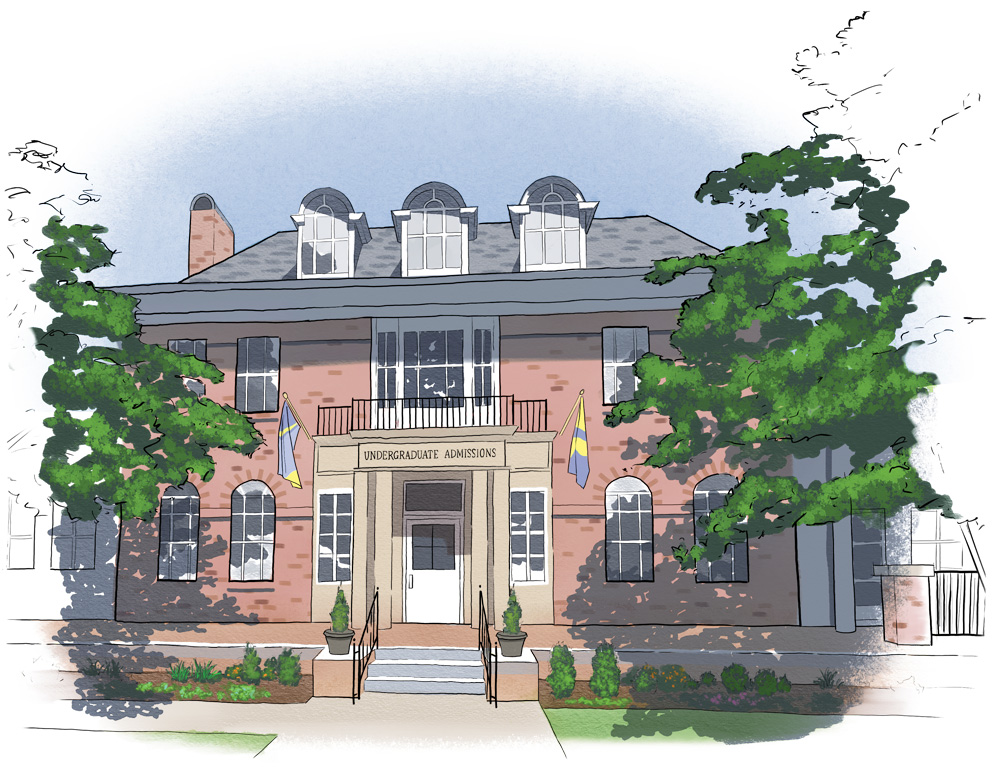
Move it on over
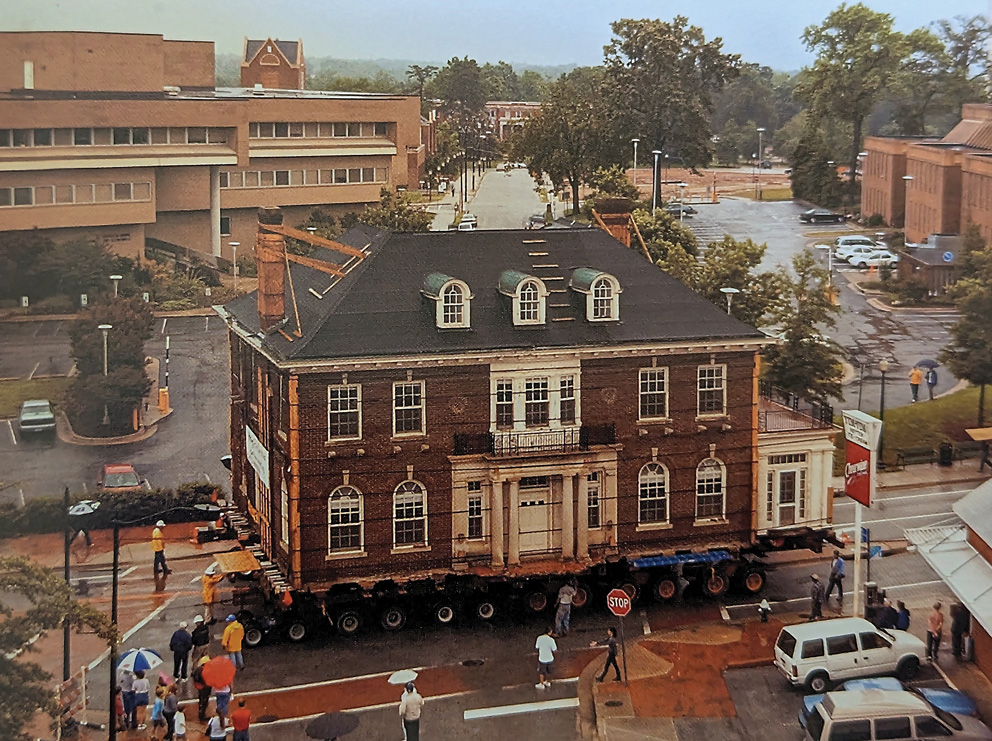
The official Chancellor’s Residence was once near the center of campus. Some alumni have tales of student protests winding their way to the chancellor’s doorstep, sometimes late at night. All the chancellors (and their families) from Julius Foust to Patricia Sullivan resided here, at the corner of Spring Garden and Forest, with Elliott Hall and Taylor Garden virtually in their backyard. In 1996, Sullivan moved to a residence the University believed would be better suited for the fundraising and related functions of the chancellor. After a great deal of debate over what should become of the campus building, built in 1922 and designed by noted architect Harry Barton, it was raised up and transported 900 feet westward on Spring Garden in 2003. Since 2005 it has served as the Armfield-Preyer Admissions and Visitor Center, named for Jane Harris Armfield ’60, ’63 MEd and Emily Harris Preyer ’39, whose families helped make its new use possible. Today, this historic building is usually the first spot new Spartans visit.
The founding president, Charles Duncan McIver, lived with his family in a house located nearby. A brass marker very near the Vacc Bell Tower denotes the location of the McIver home.
Yum Yum, known for ice cream, hot dogs, and Cheerwine, has been a part of the student experience for a century. Located for decades near the corner of Forest and Spring Garden, it moved to another building across the street in the 1970s – and now sits just a block away from the former Chancellor’s Residence.

We’ve seen this art before

McIver Building is gone, but not forgotten. The multi-paneled artwork above its main entrance lives on, at nearly the same spot. Artist Joseph Cox, a professor at NC State’s School of Design, created commissions throughout the state in mid-century, archivist Kathelene McCarty Smith notes. One remains at NC State’s D.H. Hill Jr. Library. That one has special lighting. Actually, the one at McIver did as well – originally with a green, red, and silver glow. A Carolinian editorial derisively likened it to “Christmas tree lights,” archivist Scott Hinshaw notes. It was experimental, the artist explained, and he made adjustments soon after the opening ceremony. Today, this installation of rectangular, enameled steel panels – sans the dubious lighting – lives on in the Nursing and Instructional Building, its preserved panels artfully displayed vertically on three stories. SmithGroup Architect Lori Cappuccio said, “The west common study areas provided an opportunity for ‘the old to peek through the new,’ taking advantage of the orientation and prominent visual connection to the exterior.” It’s quite a sight – especially at night.
The statue of McIver, the founding president, has stood in front of Jackson Library since 1960. For its first 48 years on campus, it was sited in front of the original McIver Building, near the present-day Nursing and Instructional Building.
The nearby Carmichael Building soundstage has a fascinating history. WUNC-TV produced shows here starting in 1955. In April 2008, as Kay Hagan ran for U.S. Senate, UNCG student journalists invited her and all primary challengers to debate here. It was the sole debate during that primary, and it drew wide coverage.
BY MIKE HARRIS ’93 MA • ILLUSTRATIONS BY ANTWAIN HAIRSTON ’21
